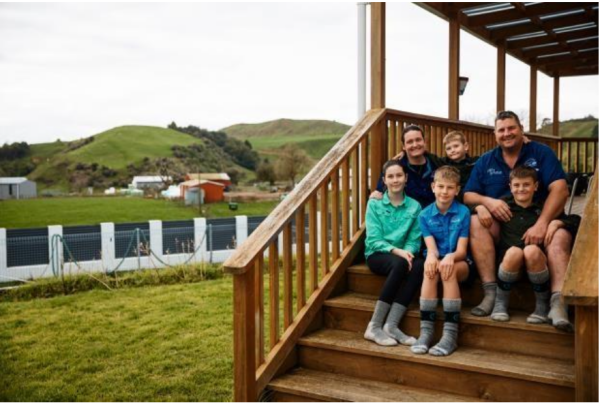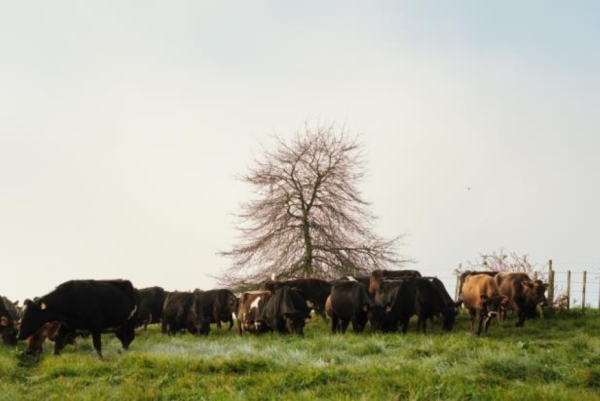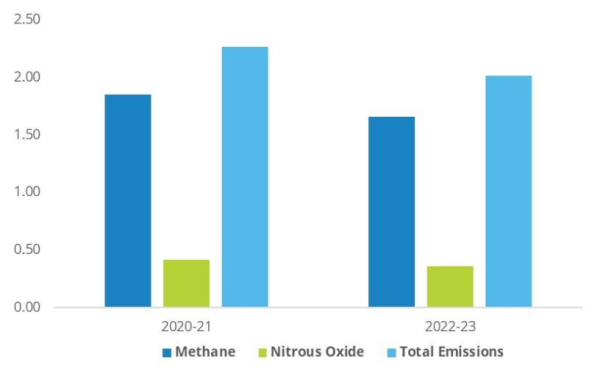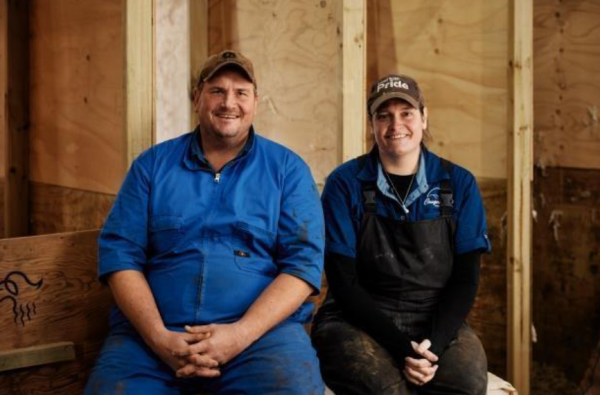Woodward Family, Ōtorohanga
Michael and Susie Woodward operate Woodward Farms Ltd on their property Cowgora Hills, near Ōtorohanga. The farm is currently peak milking 290 dairy cows, plus running 230 Angora goats on a 170-ha property with half flat-rolling and half easy hill contour, as well as running their own dairy replacements (currently 65 targeting 55 in future).
Video
Download this story
Download a copy of the Kirikiri dairy story here. [PDF, 497 KB]
Overview
The plan is to reduce to 270 peak milk cows to improve per cow production and maintain Angora goat numbers. The farm is predominantly volcanic allophanic soil. The area receives approximately 1,500 mm rainfall annually.

Michael and Susie Woodward hail from the South Island in Canterbury where they were 50:50 sharemilkers for Purata Farming at Dunsandal. In 2019, they headed north to achieve their long-term goal of farm ownership, purchasing where they now live in Ōtorohanga operating on Cowgora Hills with their four children, Kylie, John, Jack and Charlie.
The shift from the flat irrigated Canterbury plains to their Ōtorohanga property has not been plain sailing for the family, with this new location presenting different challenges in the form of weather, terrain, and animal health. Nevertheless, the Woodwards pride themselves in tackling challenges head on and they have continued to do so for the past four years on this property.
Michael and Susie are passionate about farming in a way that aligns with their values and that has shaped the way they operate their farm today, whether it be financial, environmental or social decisions.
Table 1: Woodward family land areas (ha)
|
Enterprise |
Land area (ha) |
|
Dairy milking platform |
116.5 |
|
Dry stock grazing hills |
44.8 |
|
Bush blocks |
8.6 |
What changes have been made?
Michael and Susie’s goals to further their sustainability journey, paired with their passion for the sector has led to some on-farm changes that have had positive outcomes for the environment. These on-farm actions include:
- reducing cow numbers from 320 to 290 peak milk and integrating 230 Angora goats
- implementing long term environmental and biodiversity planning through riparian planting and reducing nutrient and GHG losses
- reducing nitrogen fertiliser use from 101 kg N/ha/yr down to 75-90 kg N/ha/yr
- shift to once-a-day milking
- reduced dairy replacements required from 23 down to 20 percent
- regenerative trial on parts of farm with diverse pasture species and reduced chemicals and fertiliser.
Table 2: Woodwards farm physical parameters
|
Physical parameters |
2022 | 2027 |
|
Effective ha |
161.3 | 161.3 |
|
Peak Cows |
319 | 267 |
|
Production milk solids/cow |
359 |
393 |
|
Nitrogen usage (t) |
17.2 |
13.6 |
|
Total RSU |
3,509 |
3,246 |
Why were the changes made?
Michael and Susie have always kept the environment at the forefront and therefore knowing their greenhouse gas number is important for making future decisions.
The Woodwards are starting to get their heads around what drives emissions in their system and what changes they may be able to make to reduce them. The incorporation of Angora goats in their system was a change that enabled the Woodwards to reduce their environmental footprint and further align their system to their goals.

GHG modelling method
The farm was modelled in OverseerFM.
What have been the impacts of the changes?
Figure 1: Total biological emissions (methane and nitrous oxide) across the whole farm on a per ha/yr basis (t CO2e/ha)

Figure 1 shows the anticipated change of 9 percent in total biological emissions from 2019/20 to
2026/27. Below in Figure 2, the breakdown of greenhouse gas emissions – methane, nitrous oxide and carbon dioxide is compared.
Figure 2: Total greenhouse gas emissions (t CO2e/ha) from the Woodward’s farm in 2019/20 compared to what is projected in 2026/27.

As shown in Table 3 below, the total methane reduces slightly, however the nitrous oxide emissions have reduced by 26 percent. This reduction is a result of reduced cows wintered, reduced nitrogen fertiliser and reduced milk solid production.
Table 3: Woodwards’ family farm emissions from OverseerFM
|
Woodward Family Farm |
2020 |
2027 |
% change |
|
Total area (ha) |
170.9 | 170.9 | |
|
Total Methane (t CO2e/ha/yr) |
6.13 | 5.63 | -8% |
|
Total Nitrous oxide (t CO2e/ha/yr) |
1.84 | 1.61 | -13% |
|
Total CO2e (t/ha) |
1.52 | 1.06 | -30% |
|
Total GHG (t CO2e/ha/yr) |
9.49 | 8.30 | -13% |
|
Biological Methane (t CO2e/ha/yr) |
6.13 | 5.63 | -8% |
|
Biological Nitrous oxide (t CO2e/ha/yr) |
1.48 | 1.3 | -12% |
|
Total biological GHGs (t CO2e/ha/yr) |
7.60 | 6.93 | -9% |
|
Total Methane (kg CH4/ha) |
245 | 225 | -8% |
|
Nitrogen leached (kg N/ha/yr) |
45 | 36 | -29% |
What process did they go through to make the changes?
The Woodwards incorporation of Angora goats into their farming system eventuated after their move to the King Country. The goats complement the cows grazing habits, as well as reduce the pressure in the hills of their property.

With Michael’s father John, a pioneer in the mohair industry, much of their advice was sourced from John in the beginning changes of their system change. Much of the system change has been a result of trial and error. The Woodwards are passionate about operating a system that is doing well by the environment. They continue to review their system to plan for the future.
The Woodwards are strategic thinkers which has led to some great environmental and financial results. Michael and Susie entered the 2021 Farm Environmental Awards to understand how they might be able to improve their system further.
By 2027, the Woodwards have a plan for more changes that they hope to implement in their farm system:
- Reduce cow numbers further from 205 to 305 and retain the 230 Angora goat numbers.
- Target 15% plantain in the pasture sward for the flat-rolling half of farm.
- Breed for cows better fit to the once-a-day milking system.
- Further improve in-calf rate and in turn dairy replacements required.
- Grow 6 ha of own maize silage on farm rather than importing.
The couple actively look for ways to improve goat genetics on-farm and in turn improve the quality of the mohair product. The Woodwards have a specialist classing shed on the property where they process fibre for domestic and international markets.

What drives or constrains these changes?
With a drive to showcase to other farmers, that Angora goats can be a viable commercial opportunity, Michael and Susie have plans to design a start-up package to provide to farmers. Michael and Susie’s long-term planning has helped them to break down the environmental challenges that the sector faces to ensure that their system remains sustainable and profitable. With excellent record keeping and a plan to incorporate more technology, the Woodwards are well placed to continue to have a positive impact on the environment.
What advice do they have for other farmers?
The Woodwards have some advice for other farmers considering some form of practice or system change:
- Make sure you find something off farm to enjoy. In the busyness it is important that you find something alternative to do for even just 10 minutes after a long day of work.
- Step back and think about what is most important for you and base your system around that.
Published: July 22, 2025

